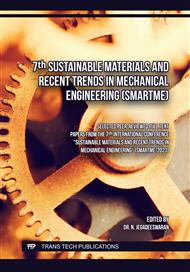p.17
p.25
p.37
p.49
p.61
p.73
p.83
p.91
p.97
Study and Comparative Analysis of Tribological Properties of Copper-Based Alloys Produced by Die Casting Method
Abstract:
This project aims to investigate and compare the tribological properties of copper-based alloys produced by the die-casting method. Tribological properties, such as wear resistance and frictional behavior, play a crucial role in determining the suitability of materials for various engineering applications. Copper has many useful properties, such as high thermal and electrical conductivity, corrosion resistance, and antibacterial properties. It is used in a variety of industries, including electrical and electronics, construction, transportation, and healthcare. The study involves conducting wear tests on various copper-based alloys using a linear reciprocating tribometer. These tests were performed under different loading conditions (5N, 10N, and 15N), varied time durations (5 min, 15 min, and 30 min), Wear rates and morphologies of the specimens were determined by SEM. The effect of composition, microstructure, and hardness on the wear behavior of copper-based alloys has been carried out. The correlation between hardness and wear resistance was analyzed. The findings of this study could provide valuable information for the selection and optimization of copper-based alloys for trigolocal applications. The copper alloys has been characterized by an optical microscope, scanning electron microscope, and Energy dispersive X-ray analysis was used to analyze the wear surfaces.
Info:
Periodical:
Pages:
61-71
Citation:
Online since:
November 2023
Authors:
Price:
Сopyright:
© 2023 Trans Tech Publications Ltd. All Rights Reserved
Share:
Citation:


